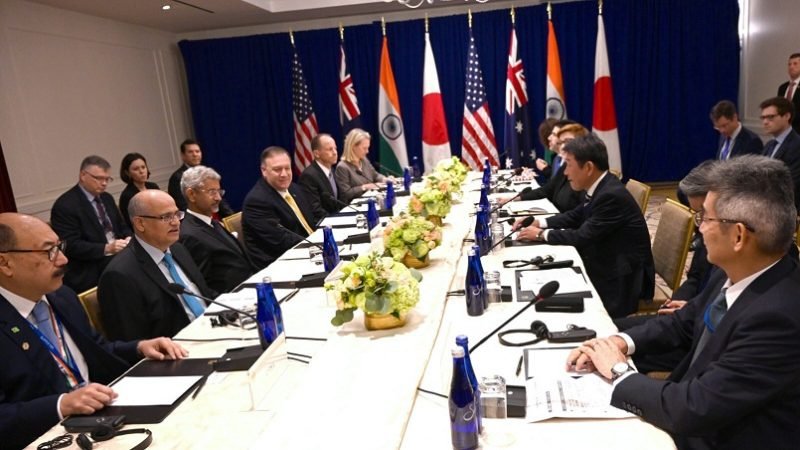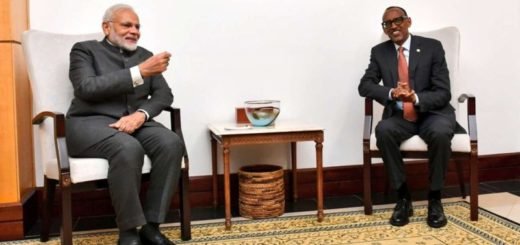The QUAD foreign ministers meeting in New York: Diagnosing the status quo

A “NATO-like” alliance in the Indo-Pacific?
The Quadrilateral Security Dialogue (Quad) between four prominent democracies of the Indo-Pacific region namely India, the United States of America (USA), Japan and Australia, on the sidelines of the 74th United Nations General Assembly (UNGA) session came as a surprise for many. The reason being this was the first time that such a meeting took place at the foreign ministerial level thereby an indication of a changing status quo, a pleasant deviation for some while raising China’s eyebrows. The recent escalation of the Quad meeting to the ministerial level comes post-Chinese cyber attack on the Australian parliament as well as on the three major political parties as well as China’s actions vis-a-vis India’s decision to revoke the autonomy of the Indian state of Jammu and Kashmir. In addition to this the other tacit triggers could include the following
- Chinese skirmishes off the Vietnamese coast within Hanoi’s continental shelf where Beijing is exploring offshore oil deposits as well as
- China pledging an investment of $400 billion in Iran right before the attack on the Saudi Aramco facility in Saudi Arabia
- Beijing’s efforts for a rapprochement with the Filipino President Rodrigo Duterte to give up on territorial disputes in lieu of majority stakes in the oil and gas exploration venture within the Philippine exclusive economic zone.
- China and Malaysia’s agreement to set up a joint South China Sea (SCS) dialogue
The Quad ever since its inception in 2007 has largely remained an informal exercise with representatives of the member states meeting each other with deliberations centred on freedom of navigation in the Indo-Pacific, maritime security, joint military exercises, disaster management, humanitarian assistance, counter-terrorism, cybersecurity etc. While no formal institutional structure exists, the Quad is seen as a countermeasure to balance China’s expansionist policies in the Indo-Pacific region. The Quad as a strategic forum was restricted solely to joint military exercises like the Malabar exercise and remained dormant until November 2017.

The Quad re-established itself in Manila in 2017 with the Prime Ministers of the member states pledging for increased engagement on the sidelines of the Association of Southeast Asian Nations (ASEAN) summit with increasing tensions in the SCS over China’s territorial claims. This latest meeting was the 5th such encounter ever since the Quad’s revival and speculations over the group becoming a “NATO-like” alliance in the Indo-Pacific remain unanswered as of now.
While the ministerial-level meeting gained a lot of attention among foreign policy observers, there has been little on the offer in the public domain on the deliberations that took place in a secret manner. Neither US State Secretary Mike Pompeo nor India’s External Affairs Minister Dr S. Jaishankar mentioned China in their answers to media questions with the former restricting his response to issues related to free navigation and de-nuclearization of North Korea. According to an article that appeared in the Chinese government mouthpiece Global Times by Zhao Minghao in the aftermath of the Quad ministerial meeting in New York
“Most Chinese observers believe that there is no need to overreact, and the key to handling the Quad is to be more active in dealing with India, Japan and Australia.”
The statement is partially valid and downplays the roles of China’s adversaries in its neighbourhood. China sees the Quad as an impediment to its Belt and Road initiative (BRI), which practically is seen by Western as well as Indian observers as a ploy of Chinese dominance through its strategy of “Debt diplomacy”. While Japan, Australia and the U.S. remain optimistic about the prospects of the alliance, India remains cautiously optimistic for various factors domestic and international. Hence, diagnosing the current stance of the members of the Quad is essential and provides insight into the strategic thinking behind any future developments of the grouping.
India’s convergent and divergent interests

The Trump administration over the last couple of years has been actively pursuing its freedom of navigation and open sea lanes of communication (SLOC’s) policy in the Indo-Pacific region. This is in congruence with India’s own interests as more than 50% of its trade passes through the Malacca Straits and SCS. However, India’s qualms are regarding the restriction of the Quad to a “NATO-like” entity in the Indo-Pacific as New Delhi by virtue of its location has its interests also in the Central Asian and greater Eurasian region. More importantly, India does not want to be perceived either as an ally of the USA nor as an adversary of China and this becomes clear with New Delhi’s diversified multi-alignment strategy and thereby maintain its strategic autonomy. In fact, Modi’s statements at the Shangri La Dialogue in Singapore last year indicates this stance
“India does not see the Indo-Pacific region as a strategy or as a club of limited members. And by no means do we consider it as directed against any country.”
Indian Prime Minister, Narendra Modi at Shangri La Dialogue
This statement, however, does not find resonance with Washington who wants to treat India as an ally and a reliable partner in the security of the Indo-Pacific where according to the US “geopolitical competition between free and repressive visions of world order is taking place”. Washington views the Quad as a synergy of its two important trilateral engagements which are the US, Japan & Australia and the US, Japan & India. As a part of this, India was provided access to real-time intelligence information as a part of the communications compatibility and security agreement (COMCASA) with the US as well as the Naval surveillance and submarine detection aircraft like the P-8I’s. Despite such offers, other US’s interests or rather Trump’s electoral fortunes in 2020 seem to override the good chemistry between Modi and Trump with Washington revoking India’s Generalized System of Preferences tag as well as imposing restrictions on oil imports from Iran and the threats of imposing the Countering American adversaries through sanctions act (CAATSA) on India purchasing S-400 missile defence from Russia. These conflicting signals make India stay vary of the US intensions and keep New Delhi away from a full-fledged engagement as a part of the Quad. The US
Another important hurdle for India from pro-actively engaging with the Quad is its land border with China which all the rest of the members lack. In New Delhi’s understanding, it has to contend with two adversarial neighbours with land borders with itself who are allies and engaging in two-front warfare would be detrimental to its economic growth and other domestic interests. The informal summit last year in Wuhan between President Xi Jinping and Modi addressed several such issues of mistrust and gave birth to the concept of “Wuhan Spirit”. This nevertheless seems to have already fizzled out with the August 5th moves of revoking Article 370. China termed the decision unilateral and even called for a closed-door meeting of the UNSC. India’s other interests include Eurasia, where there is likely to be a shift of influence to Russia and China post troop American troop withdrawal in Afghanistan. Moscow’s increasing alignment with Beijing in matters of international importance complicates matters for New Delhi as Russia has remained an important partner for decades. Also, New Delhi has gone beyond the usual defence engagement with Moscow and sees an opportunity for an economic partnership by cooperating in energy extraction in the Russian Far East as well as in the Arctic regions.
The way ahead for the Quad
The centrality of the ASEAN in the Indo-Pacific is something that the Quad has to take into consideration for rejuvenating the dialogue and as a deterrent to China. Most ASEAN states have territorial disputes with China and this provides an opportunity for working together in safeguarding interests as well as in securing navigation along the SLOC’s in the region. China’s coercive tactics in its engagement with the ASEAN members as mentioned previously could have major consequences in the SCS as these powers cannot balance Beijing without the support of powers like the Quad. A joint effort of arbitration by the Quad in conjunction with the ASEAN member states at the international level could be a clear indicator of the effectiveness of the grouping. Joint military exercises such as the recent Malabar exercise, U.S.-ASEAN Naval exercise and other bilateral exercises need to be conducted regularly.

France has always been India’s ally however off late by virtue of having its territories in the Indo-Pacific have hinted at increasing engagement in the region which is evident from the joint bilateral statement on Modi’s visit to Paris recently. France’s involvement with the Quad in the Indo-Pacific could prove to be a catalyst in forging stronger formalization of the grouping and further lend strength to the balance of power equation in the region.
In conclusion, the Quad foreign ministerial meeting in New York is a welcome move and signals a renewed understanding among the members themselves as well as to Beijing. India’s balancing act as with its policy of multi-alignment impedes its proactive engagement in the framework of the Quad which is exacerbated by American actions vis-a-vis India in the recent past. Engagement with the ASEAN with regards to the maritime territorial disputes with China and arbitration over the same at the international level can display the Quads effectiveness. Finally, France’s involvement in the security of the region can help strengthen the Quad and can prove to be a bigger deterrent to China in the region.



















